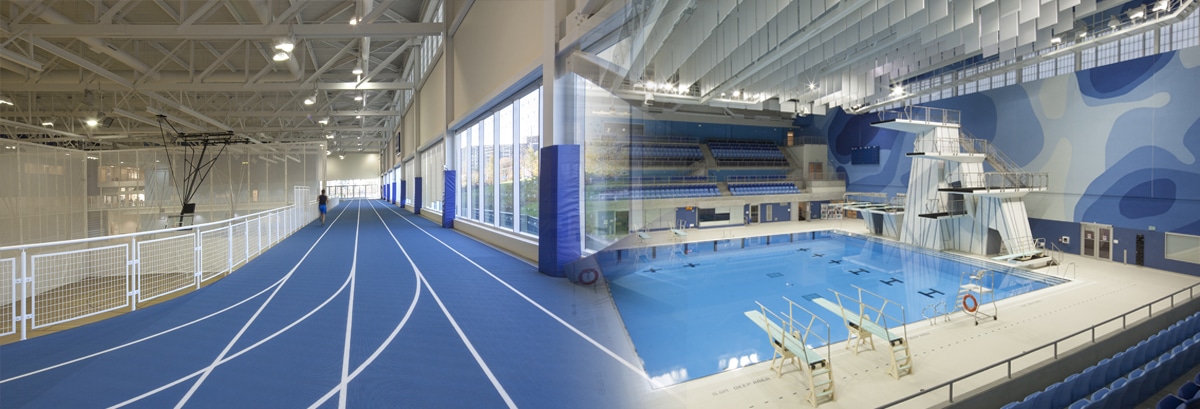The Toronto Pan Am Sports Centre
Toronto, Ontario
April 7, 2015
- Rating System/Standard
- LEED v1
- Certification Level
- Gold
- Building Type
- Sports Facility
Large athletic facilities can pose a unique challenge in green building, as their footprint needs to be larger than a standard building in order to house Olympic-sized swimming pools and running tracks, accommodate tens of thousands of spectators for events, and include the additional amenities and services needed. Despite this, more and more projects are seeing their large-scale as less of a problem, and more of a chance for design innovation.
In the lead-up to the 2015 Pan Am and Parapan American Games, this has been the goal: to build infrastructure that will not only accommodate large numbers of tourists and visiting athletes and staff, while being equipped to hold world-class athletic events – but that will leave a lasting legacy of sustainability for the citizens of Southern Ontario who will be using these facilities for years to come.
The following case study was written using responses previously provided for a LEED Spotlight in April 2015, and is the result of an interview with Jim Derenzis, Director of Facilities Management for the University of Toronto Scarborough.
Project Team
- Project Owner
- Infrastructure Ontario
- Project Sponsors
- City of Toronto, University of Toronto Scarborough, Federal Government (with stewardship by PAN AM 2015).
- Developer & Design-Builder
- PCL Constructors Canada Inc.
- Architect
- NORR Ltd./Counsilman-Hunsaker
- LEED / Sustainability Consultant
- Halsall Associates
- Mechanical & Electrical Consultant
- Smith + Andersen
- Structural Engineer
- Halsall Associates
- Landscape Architect (if applicable)
- Janet Rosenberg + Associates
- Major Subtrades
- Plan Electric, Urban Mechanical, International Pool Constructors
- Commissioning Authority
- Halsall
A building that proves the value of having a healthy building in helping athletes achieve their best
Co-owned by the University of Toronto and the City of Toronto in a unique partnership, the Toronto Pan Am Sports Centre is a hub of activity and collaboration for University of Toronto students, members of the community, and high performance athletes, underpinned by a shared value of a healthy, active lifestyle. As a legacy venue for the Pan Am & Parapan American Games (meaning it will continue to be used following the event), the third largest international multi-games competition in the world, the facility will host swimming, diving, synchronized swimming, fencing, Modern pentathalon, sitting volleyball and in-line roller speed skating events.
This state-of-the-art building is the largest new-build sports facility for the 2015 Pan Am & Parapan American Games, and is considered one of the largest investments in Canadian amateur sport history. At 393,628 square-feet, it includes seating for 8,000 Games spectators, two internationally sanctioned 10-lane 50-metre pools, a 5-metre deep diving tank, a four-court gymnasium, an indoor walking/running track, a climbing wall, conditioning rooms, a high performance testing centre, studio spaces, and a state-of-the-art fitness centre.
In addition to hosting the Pan Am Games and providing facilities for University of Toronto Scarborough (UTSC) students and community members, the sports centre is home to the Canadian Sport Institute Ontario, the leading high performance sports organization in the province, and Wheelchair Basketball Canada’s National Academy. In addition, Diving Plongeon Canada, Swimming Canada, Synchro Canada and Water Polo Canada have moved components of their training programs to the facility.
The Toronto Pan Am Sports Centre is built to the highest standards of accessibility, from entrances and pathways to dressing rooms, lockers, washrooms and showers. There are also tethering stations for service animals available throughout the building, and emergency provisions include areas of refuge and an evacuation chair; medical and treatment rooms include height adjustable tables.
LEED Gold achieved through partnerships
The partners, together with Infrastructure Ontario, specified that design and construction of the facility would adhere to the guidelines and sustainability principles of the LEED rating system, the most widely used and industry recognized green building rating system. In addition, the project set out to comply with the City of Toronto’s Toronto Green Standard (TGS).
The professionals on the delivery team including PCL Constructors Canada Inc., are practiced at designing and constructing projects to the LEED standards, benefitting both the design/build team and the owners. With the evolution of environmentally conscious building practices, what was considered a premium service has become standard to the way PCL builds. With an initial target of achieving LEED Silver for the facility, PCL, in partnership with LEED consultant Halsall Associates, was able to maximize value to achieve an even higher level of intended certification, LEED Gold, which stands as a testament to the value of strong partnerships and close collaboration.
What drove the U of T and the City of Toronto to build green
We are driven to be leaders in institutional environmental responsibility as well as provide the facility with operational benefits and cost effectiveness over the long term. UTSC is known for leading scholarship in the environment—addressing the social and ecological dimensions of natural resources and the environment to improve sustainability. That’s why at UTSC, being green means being connected—to the local farmers who supply our food outlets, through our academic endeavours, and by our responsibility to future generations.
We are committed to building a sustainable community through outreach and education on important issues like climate change, resource valuation, and conservation. We’re planning responsibly, preserving resources and reducing our environmental impact. Faculty, staff, and students are reducing our environmental footprint by conserving energy, promoting renewable energy, alternative transportation and recycling.
The value of certification for athletes, students and the community
This certification demonstrates the social responsibility taken on by the owners and by the federal government, as well as the global audience that will be attending the games. Building facilities with sustainable features ensures environmentally-responsible and efficient buildings that will last for years. UTSC has enthusiastically incorporated energy conservation strategies in the operation, renovation and construction of our facilities, which legitimizes our efforts and provides direction for future campus growth. These principles have been incorporated into our current academic expansion project, and will be further established with additional design innovations, such as earth tubes at the campus’ newest build, the Environmental Science and Chemistry Building (ESCB).
We’re making significant progress by altering how we design, build, operate and maintain our facilities to ensure that we efficiently use natural resources. These projects help the campus conserve energy, reduce the use of raw materials and save money. Over time, more members of our community will live, work and learn in increasingly efficient buildings while enjoying a higher standard of indoor environmental quality.
Performance standards/goals
Because swimming pools of this nature generally have significant utility consumption rates, we were particularly interested in targeting optimized energy performance, which was achieved through use of:
- Geothermal energy through a ground source heat pump (GSHP) field located under the north parking lot of the facility, comprised of 100 geothermal boreholes, extending 600 feet deep each.
- Building envelope materials that combat high humidity and contribute to overall building envelope and energy performance.
- Unique air handling units that prevent condensation and reduce the energy demand required to heat the pools.
Through a comprehensive waste management plan, PCL ensured that 95 per cent of construction site waste from the project was diverted from landfill.

Energy and water savings
The facility has been designed and built to optimize energy performance, achieving a 40 per cent reduction in design energy cost over the Model National Energy Code for Buildings (MNECB) reference building. The project achieves a 37 per cent water use reduction over baseline fixture performance requirements and 100 per cent of the facility’s property irrigation demand is met using non-potable rainwater harvested by underground cisterns buried in various locations.
Positive health impacts
The building provides a brighter and healthier indoor environment for the community, as well as reduced utility cost and maintenance burden that will allow the facility to remain this way long into the future. Some of the ways this is accomplished include:
- LED lighting that is more efficient and less harsh.
- Effective, efficient and environmentally friendly pool air and water treatment systems.
- Effective use of sightlines and visibility to the vast open spaces, and to the street.
- Synergized offering of services from fitness, to high performance, to therapeutics.
Measurement and verification systems, advanced building automation controls and energy management systems have been incorporated into the building so the owner can actively monitor its performance, and respond dynamically to changing operational needs.
A first for the University of Toronto
This is the first new building at the University of Toronto to achieve LEED Gold. Constructed on time and on budget, the project was completed following an aggressive 24-month schedule, enabling the facility to begin operations and complete testing events one year prior to the Games.
Recently, PCL was awarded the 2015 Ontario General Contractors Association award for Best Project Built in Ontario, as well as the Best of the Best Large Project Achievement Award from the Toronto Construction Association.
We are extremely proud of this facility, a winner by international standards, as well as the opportunity to provide a showcase for leading edge environmental design in this jointly-owned City and University facility. As the Americas converge at the Toronto Pan Am Sports Centre for the 2015 Pan Am & Parapan American Games this summer, many of the building innovations will be featured so that other nations can learn about sustainable design.
Additional project strategies and results
- Containing mostly sedum mixes that were pre-grown and transplanted to the site where they were planted in an optimal four-inch depth growth medium, the green roof covers 5,632 m2 of the building’s roof (30 per cent).
- Overall building materials are comprised of 30 per cent recycled content.
- 100 per cent of the facility’s property irrigation demand is met using non-potable rainwater harvested by underground cisterns buried in various locations.
- 1,854 solar panels installed on the roof can generate up to 593 kW of power per hour, reducing energy consumption of the building by up to 10 to 15 per cent.
- LED lighting throughout the building consumes 80 per cent less energy than incandescent, and about 35 per cent less than fluorescent.

LEED SCORE CARD
| Certification Level | Gold |
| Rating System | LEED Canada for New Construction and Major Renovations 1.0 |
| Total Points earned | 63 |
| Sustainable Sites | 16 out of 26 |
| Water Efficiency | 7 out of 10 |
| Energy & Atmosphere | 17 out of 35 |
| Materials & Resources | 6 out of 14 |
| Indoor Environmental Quality | 9 out of 15 |
| Innovation | 5 out of 6 |
| Regional Priority | 3 out of 4 |
